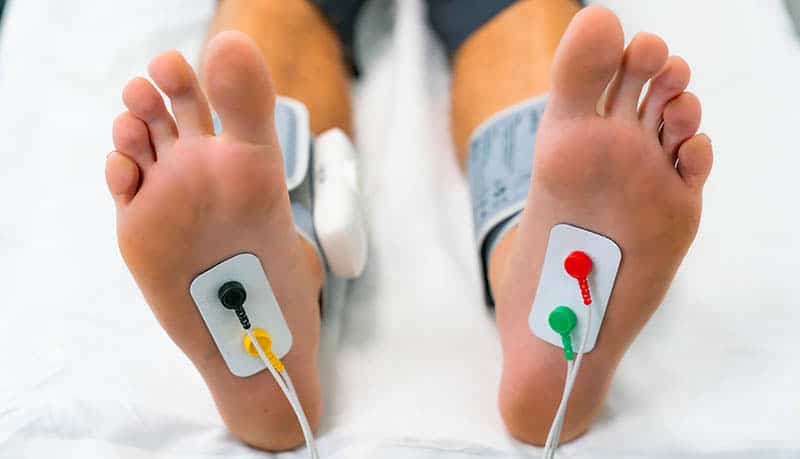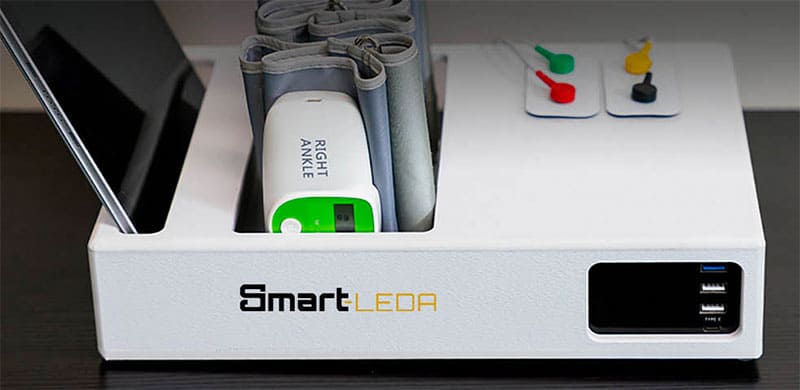Do you feel pain in your legs after walking or climbing stairs? Notice that one leg feels colder than the other, or maybe you feel ankle pressure or pain in your lower limbs?
These can be signs of a circulation problem that shouldn’t be ignored, as those are common symptoms of Peripheral Artery Disease (PAD) or Peripheral Vascular Disease (PVD).
University Foot and Ankle Institute offers a quick and easy test to determine if you have peripheral artery disease for our patients in Los Angeles, Santa Monica, and the Westlake Village area. Called an ankle-brachial index test (also known as a smart-ABI test), it is a simple blood pressure measurement in two places in your body that can determine if the circulation issue in your legs is PAD.
What is Peripheral Artery Disease (PAD)?
Peripheral artery disease (PAD) is a heart disease-related condition that affects the blood vessels outside the heart and brain, most commonly in the legs. It occurs when fatty deposits build up in the inner lining of arteries, causing them to narrow and harden. This restricts blood flow to the legs, leading to symptoms such as pain, cramping, numbness, weakness, and fatigue in the legs, especially during physical activity.
What is the difference between Peripheral Artery Disease and Peripheral Vascular Disease?
Since a Smart ABI test can detect both of these circulation conditions, let’s take a moment to explain the difference between these two conditions.
Peripheral artery disease (PAD) and peripheral vascular disease (PVD) are terms that are often used interchangeably, but they have some differences.
PAD specifically refers to a condition where there is a narrowing or blockage in the arteries that supply blood to the legs, feet, arms, or hands. This can lead to pain, numbness, or cramping in the affected limb, especially during exercise or physical activity. PAD is most commonly caused by atherosclerosis, a buildup of plaque or calcification in the arteries.
PVD, on the other hand, is a broader term that refers to any condition that affects the blood vessels outside of the heart and brain. This includes conditions that affect both arteries and veins. PVD can be caused by a variety of factors, including atherosclerosis, blood clots, and inflammation.
So, while PAD is a specific type of PVD that affects the arteries in the limbs, PVD encompasses a wider range of vascular conditions that affect the blood vessels outside of the heart and brain.
What are the Common Risk Factors for Peripheral Artery Disease?
PAD is most commonly caused by atherosclerosis, a buildup of plaque on the walls of arteries.
Some high-risk factors for PAD include:
- Diabetes
- Smoking (cigarette)
- 50+ years old
- High Blood Pressure
- High Cholesterol
- Obesity
- Family History
What are the Common Symptoms of PAD?
Symptoms of PAD can include:
- Cold lower extremities (the leg and foot)
- Fatigue when walking
- Numbness or weakness in the leg, cramping in the hips, thighs, or calf muscles after activity
- Changes in skin color, shiny skin,
- Slower hair and toenail growth on the affected leg
- A weak pulse, or lack of pulse, in the legs or feet
- Sores on the legs, feet, or toes that don’t heal
- Arm pain when doing everyday tasks like writing
- Erectile dysfunction.
What Happens if PAD is Left Untreated?
If left untreated, PAD (as well as peripheral vascular disease) can lead to serious lower extremity complications such as leg pain, ulcers, gangrene, and even amputation. As the PAD worsens, the patient’s pain will eventually occur at rest or when lying down.
The danger in PAD is that muscles and other tissues can’t function properly without enough blood flow to deliver nutrients and oxygen to them. Leg sores from PAD, and other leg injuries, simply can’t heal without the nutrients in the blood.
Without healing nutrients, those sores and injuries can develop gangrene. There is no cure for gangrene – tissue damaged by gangrene must be amputated – but there are treatments to keep it from getting worse. Fast treatment can keep gangrene from getting worse, but the best prevention is to diagnose and treat PAD before it advances.
How do we test for peripheral artery disease (PAD)?
Smart Ankle Brachial Index, also known as Smart ABI, was designed to make it easy for physicians to test patients who doctors suspect may have or are at risk for PAD.
The device is a non-invasive test and simply involves placing an inflatable cuff around the patient’s upper arm and ankle to get a number of blood pressure readings. What it does is calculate the differences between the arm and ankle pressures.
The machine uses a Doppler ultrasound device to test for blood flow by taking systolic blood pressure measurements from the blood pressure cuffs. The ABI value is easily calculated by the readings from the machine. The ABI value determines the level of blockage or narrowing in the arteries to diagnose PAD.
Once the test has been conducted, a report is created for our healthcare provider that includes intelligent, quantitative, and color-coded graphic scores that indicate a Normal, Borderline, or Severe risk for PAD.
After the first test, the patient’s information is saved in the software and serves as their baseline data. This allows the doctor to accurately track the patient’s trends over time to know if they are improving or worsening.
What are the advantages of our Smart ABI test?
- It Is fast as it only requires a 5-minutes of the patient’s time.
- It does not require further waiting time for test results from your healthcare provider.
- Since the machine is in our office, it is very easy to schedule tests.
- It uses safe Bluetooth wireless cuff technology for comfortable pulse volume recordings and volume plethysmography.
- It can easily track patient improvements or declines over time.
How our Podiatrists Utilize Smart ABI to Help Test for PAD (Peripheral Arterial Disease)
Peripheral Arterial Disease can often lead to difficulty walking, pain in the extremities, slower healing, and even the loss of a limb. We use Smart ABI as part of our physical examination to test and accurately diagnose patients who could be at risk for PAD.
Currently, the American Heart Association, the experts in cardiovascular health care requests that all patients who could be at risk for PAD should be tested. The Smart ABI enables a short test that measures a patient’s Ankle Brachial Index or ABI. It also measures blood pressure in the ankle area, body mass index, and blood pressure in general.
How is PAD treated?
There is no outright “cure” for peripheral artery disease (PAD), but it can be managed and treated to alleviate symptoms, slow down its progression, and reduce the risk of complications. Treatment for PAD may include:
Lifestyle changes:
- Quitting smoking
- Eating a healthy diet, low in saturated and trans fats
- Exercising regularly
- Maintaining a healthy weight
- Managing blood pressure, cholesterol, and blood sugar level
Medications:
- Cholesterol-lowering drugs (e.g., statins)
- Blood pressure medications
- Antiplatelet or anticoagulant medications to prevent blood clots
- Medications to alleviate leg pain during physical activity (e.g., cilostazol)
Medical procedures or surgeries:
- Angioplasty, where a small balloon is inflated inside the narrowed artery to widen it
- Stenting, where a small mesh tube is placed in the artery to hold it open after angioplasty
- Bypass surgery, where a healthy blood vessel is taken from another part of the body and used to create a new path for blood flow around the blocked artery
Get a Fast, Painless Smart-ABI Test for PAD at University Foot and Ankle Institute
Remember, early detection is key to treating PAD effectively, so don’t ignore the signs of PAD. If you experience any of these symptoms, make sure to ask your doctor about our ankle-brachial index test.
This test will ensure that you get the treatment you need to avoid the risk of worsening cardiovascular disease, heart attack, amputations, and future vascular surgery.
To schedule a consultation with one of our renowned podiatrists please call (855) 872-5249 or make an appointment now.
We are conveniently located through the Los Angeles area with podiatry clinics in or near Santa Monica (on Wilshire Blvd.), Beverly Hills, West Los Angeles, Manhattan Beach, Northridge, Downtown Los Angeles, Westlake Village, Granada Hills, and Valencia, California, to name a few. We are happy to offer a house x-rays, imaging, and physical therapy clinic.
- Flip-flops Causing You Pain? Protect Your Feet This Summer! - April 23, 2024
- 9 Running Tips from Sports Medicine Experts - November 8, 2023
- Common Foot Problems In Aging Feet: What To Watch Out For - October 16, 2023

